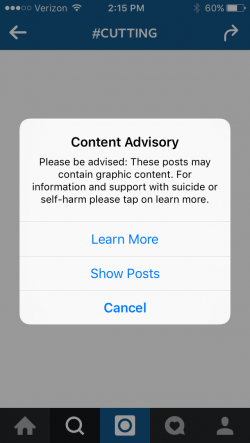 Search the hashtag #cutting on Instagram, and you’ll be served up a warning like the one pictured on this post. That’s because there are more than 4,000,000 photos on the platform, many showing graphic displays of self-harm by cutting.
Search the hashtag #cutting on Instagram, and you’ll be served up a warning like the one pictured on this post. That’s because there are more than 4,000,000 photos on the platform, many showing graphic displays of self-harm by cutting.
Cutting is a non-suicidal form of self-injury. It's the causing of physical pain to numb emotional pain, and is frequently used during times of intolerable distress as a coping mechanism.
Most of the time, cutting is highly secretive and ritualistic. Scars are hidden beneath long pants or sleeves.
A recent (and concerning) phenomenon in the age of social media is a trend toward teens using cutting as a sort of initiation into a social clique, or a way to identify as part of a group.
Teens may be introduced to the idea of cutting from a friend, by accident, or through experimentation. In the case of cutting to fit in, initially, the goal may be social acceptance. When someone is seeking social acceptance, cutting photos may be taken and displayed in a glorified manner on social media for friends to see.
The problem is that cutting can be highly addictive. It’s like trying a drug for the first time - the release from cutting can easily become a way to rapidly self-soothe in moments of distress.
So what began as a way to fit in can quickly spiral into an unhealthy coping mechanism for life’s stressors.
It’s estimated that 15% of teens and 17% of college students have engaged in self-injury, which could include methods like cutting, burning, hair-pulling, skin picking, burning, head banging, swallowing objects/substances, nail biting, cutting off circulation to a digit, or something else.
If peer pressure is causing a teen to cut, this can act as a gateway into a longer-term cycle of self-harming behavior. And, unfortunately, parents are typically the last ones to find out.
Some red flags parents should watch out for in their teens:
- Strong desire to do what it takes to “fit in”
- Blood on clothing or in bathroom or bedroom
- Sharp instruments missing or misplaced
- Long sleeves worn during warm weather
- Increasing isolation behaviors
- Decrease in performance academically, athletically, or otherwise
- Decrease in hygiene
It can also be a good idea to generally keep an eye on teens’ use of the internet and social media sites. Here are some tips on how to do that; it’s your right to know what they’re up to.
If cutting is discovered, it’s important to keep a few things in mind:
- Take this behavior seriously, and convey to your teen that it’s not ok. Don’t blame your teen; show support. This is not something that will be outgrown, so it’s important to engage right away.
- Know that this is almost never suicidal behavior. Your teen is most likely trying to achieve comfort – using it as a way to feel better – really, to avoid suicide. (However, accidental suicide is real when it comes to cutting, so don’t wait to take action.)
- Your teen probably won't respond well to constant questions. They are seeking trust and comfort. As a parent or loved one, try to find a happy medium by showing concern, but focus on safety vs. the behavior.
- Get rid of the “kit” or access to the preferred method of self-harm, whether that be a paperclip, razor blade, scissors, etc.
- Engage a therapist. As part of recovery, the therapist will most likely work with your teen on one major goal of treatment, which is to substitute the behavior with a less-destructive replacement behavior like snapping a rubber band or rubbing ice against the skin, writing in a journal, listening to music, or something else distracting. Dialectical Behavior Therapy has also been proven to support healthy regulation of emotions relating to self-harm.
- Encourage your teen to have a trusted ally or friend to call upon when the urge to cut strikes. A parent can fill this role, but it’s more likely a teen will feel most comfortable with a friend or mentor.
If you’re worried about your teen or a loved one engaging in self-harm, either speak to your family physician or school counselor, or call a crisis hotline such as 1-800-273-8255. You can also call Sheppard Pratt’s Therapy Referral Service at 410-938-5000 on weekdays between 8 a.m. and 4:30 p.m. If your child is in immediate danger, call 911. There is hope. Your child deserves to know: you don’t have to cut to fit in!
Benedicto Borja, M.D., is medical director of Crisis Services at Sheppard Pratt Health System.